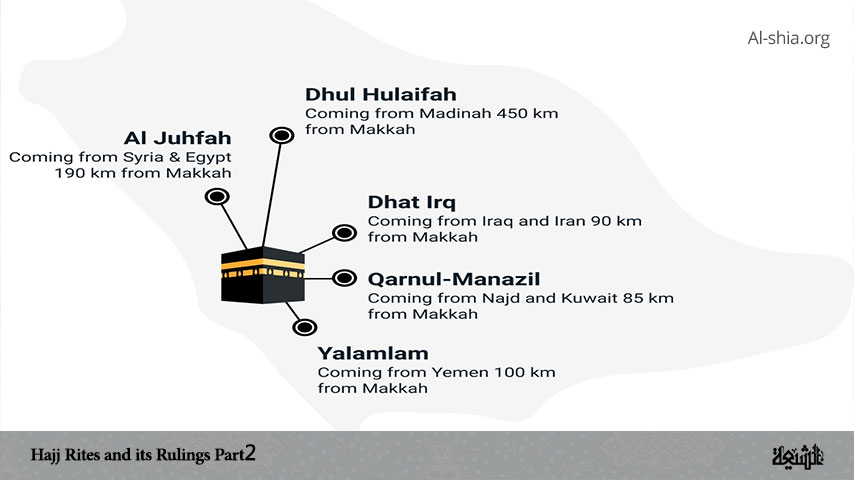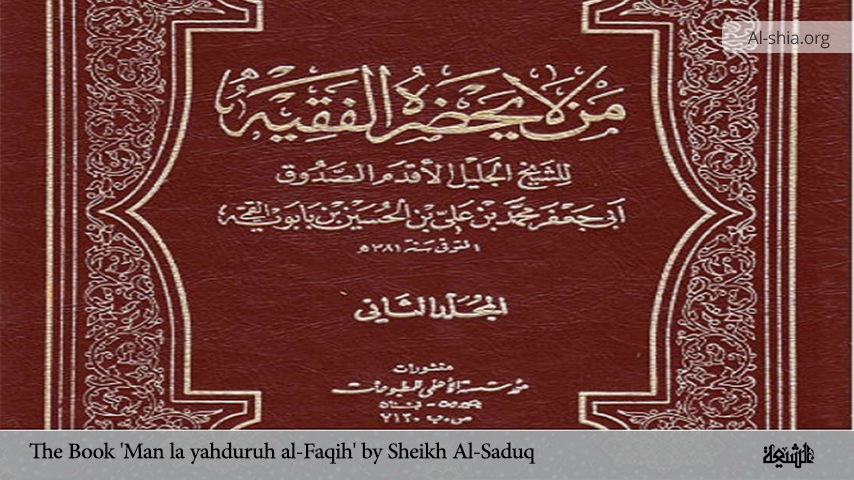In continuation of the selected rulings on Hajj rites based on the religious verdicts (Fatwas) of His Eminence, Grand Ayatollah Sistani (May his authority be prolonged) we shall be discussed some selected rulings related to Meqats (designated places) for wearing ihram as follows:
There are special places designated by the sacred rules of Islam for wearing the ihram. It is incumbent on the pilgrim to wear the ihram there before visiting the Ka’ba and moving towards Mecca.
Places of Meqat
There are nine such places, each of which is called Meqat:
1. Thul Hulaifah: This is situated near Madinah. It is the Meqat for the people of Madinah and all those who wish to perform the pilgrimage travelling from Madinah. As a matter of caution, it is preferred that the ihram be worn, if possible, in the local mosque known as Masjid-ush-Shajarah. It is insufficient, though, to wear it outside, except for ladies in menstruation or the like.
NOTE: It is not permissible to delay wearing the ihram from Dhul Hulaifah and wearing it at Johfa instead, except for a valid reason, such as sickness or due to weakness.
2. Wadil-Aqeeq: This is the Meqat for the people of Iraq and Najd and those passing through there. It has three parts: Maslakh, Ghamrah and Thati Irq. The preferred opinion is for a pilgrim to wear his/her ihram before reaching Thati Irq, if there is no case for dissimulation (Taqiyyah) or illness.
NOTE:
It has been said that in dissimulation, it is permitted to wear ihram secretly before Thati Irq without removing all clothes. On getting there, the clothes may be removed and the ihram is worn without incurring any kaffarah (penalty). However, this opinion is not free from ishkal.
3. Johfa: This is the Meqat for the people of Syria, Egypt and the West and those who pass from there if they have not worn ihram earlier at Thul Hulaifa either with or without excuse.
4. Yalamlam: This is the Meqat for the people of Yemen and those who pass from there. It is the name of a mountain.
5. Qarn-ul-Manaazil: This is the Meqat for the people of Ta’if and all those who pass through that route.
NOTES:
It is pertinent to mention that in the last four Meqats, i.e., numbers (2) to (5), the Meqats are not confined to the mosques only, but all that which comes under the banner of these places is so considered.
If the pilgrim is unable to specify the exact place, he can wear the ihram by making a vow (nadhr) before reaching the Meqat.
6. The proximity of any of the above-quoted Meqats: If a person takes a route which does not cross any of the said Meqats, he must wear ihram from any place which is parallel to the Meqat, that is to say, a place at which, when he faces the Holy Ka’ba, one of the Meqats would be to his right or left, and when he proceeds from that point to Makkah, the Meqat would be behind him. It is sufficient to use common sense to determine if one has reached such a point; it is not necessary to take exact measurements. If a person takes a route on which he reaches a place which becomes parallel to two Meqats, it, as a matter of preferential precaution, is recommended that he should wear an ihram on reaching the first of such two places.
7. Makkah: This is the Meqat for Hajj-ut-Tamatu’, as well as Hajj-ul-Qirān and Ifrād for the residents of Makkah, and its neighbourhood – irrespective of whether or not their obligation shifted to that of the residents of Makkah – as they are not required to proceed to the rest of the Meqats.
However, it is preferable for all, except women, to proceed to some other Meqats, such as Ja’ranah to wear their ihram. As a matter of precaution, one should wear ihram at a place within the area considered as part of the ancient Makkah at the time of the Holy Prophet (s.a.w.a), although it is permissible to wear it at one of the new places recently built, except those which would fall outside the Haram.
8. The pilgrim’s home: This is the Meqat for those who are nearer to Makkah than the Meqat as it is permissible for them to wear ihram from their homes and are not obliged to return to a Meqat.
9. Adnal Hil like Hudaybiyyah, Ja’ranah, or Tan’eem: It is the Meqat for Umrat-ul-Mufradah after the Hajj-ul-Qirān or Ifrād and all Umrat-ul-Mufradah by those in Makkah.
Rules of Meqats
Rule 1: It is not permissible to wear ihram before reaching Meqat nor is it enough just to pass from there in ihram. There is no alternative to wearing the ihram at the Meqat itself. However, there are two exceptions:
i) If a pilgrim has made a vow (nadhr) to wear ihram before the Meqat, it is valid to do so, it is not necessary to renew it at the Meqat, or pass through it. Indeed, it is permissible to proceed straight to Makkah without passing through any Meqat. In this regard, there is no difference between an obligatory and an optional pilgrimage or Umrat-ul-Mufradah. However, if the ihram is for an obligatory pilgrimage, then it is necessary that he should wear the ihram in the season of the pilgrimage, as has already been discussed.
ii) If a pilgrim wishes to perform Umrat-ul-Mufradah in the month of Rajab, and fears that the month will elapse before he proceeded to the Meqat, it is permissible to wear the ihram before the Meqat and it will count as the Umrah of Rajab, even if the remaining ceremonies were performed in Sha’ban. In this regard, it does not matter whether the Umrah is obligatory or optional.
Rule 2: It is obligatory for the pilgrim to be certain that he reaches the Meqat and wears the ihram there. He must be satisfied or have shari’a proof that the place is the Meqat. It is not permissible to wear the ihram if there is doubt whether the Meqat has been reached.
Rule 3: If a pilgrim had made a vow to wear ihram before Meqat and contrary to it wears ihram at the Meqat, his ihram is not invalidated. However, he must pay kaffarah for infringing the vow, if he did so deliberately.
Rule 4: Just as it is not permissible to wear an ihram before reaching Meqat, so is it not permissible to delay wearing it. It is not permissible for a person who intends to perform a pilgrimage or Umrah or to enter the Haram or Makkah to pass by the Meqat, by choice, without wearing an ihram there, even if there is another Meqat ahead. If a pilgrim passes by a Meqat, he must, if possible, return to it to wear the ihram. There is one exception for those who pass Thul Hulaifah to Johfa, without excuse. In such a case, it is evident that wearing the ihram from Johfa is sufficient, albeit he is sinful. As a matter of precaution, it is not permissible to pass any place which is parallel to one of the Meqats without wearing an ihram, although one can ignore this precaution because there is another Meqat ahead or parallel. If a passenger does not intend to perform a pilgrimage or enter Makkah but changes his mind after passing Meqat, he can wear an ihram for Umrat-ul-Mufradah from Adnal Hil
Rule 5: If a pilgrim passes by a Meqat deliberately without wearing an ihram, without prejudice to the previous rule, there are two possible avenues:
i) If it is possible to return to the Meqat, it is obligatory to do so and wear the ihram there; it makes no difference whether he returns after having entered the Haram or from outside it; if he does so, his pilgrimage is valid.
ii) If the pilgrim is not able to return to the Meqat, whether he is inside or outside the Haram, his pilgrimage is invalidated and wearing the ihram from any place beyond the Meqat is not sufficient. He must perform the pilgrimage in the ensuing year if he has the means.
Rule 6: If a pilgrim abandons wearing ihram due to oversight, unconsciousness, and the like, or ignorance of the rule or Meqat, four situations would arise:
i) If it is possible to return to the Meqat, it is obligatory to do so and wear ihram there.
ii) If he is in the Haram and it is not possible to return to the Meqat, and it is possible to come out of the Haram, he must go outside and wear an ihram there. It is preferable that, having made his exit from the Haram, he must proceed as far away from it as possible to wear ihram.
iii) If he is in the Haram and it is not possible to come out, he must wear an ihram wherever he is, even if he has entered Makkah.
iv) If he is outside the Haram but it is not possible to return to the Meqat, as a matter of precaution, he must return as far as possible towards the Meqat and wear an ihram.
In all these four situations, the pilgrimage is valid, if the pilgrim acts in accordance with what is stated above. The same rule applies to a person who wears an ihram before reaching Meqat, or after leaving it out of ignorance, or due to an oversight of the rule.
Rule 7: If a woman pilgrim, who is in menstruation (Haydh), does not wear ihram at Meqat out of ignorance of the rule and enters the Haram, as a matter of precaution, she must go out and wear ihram, if it is not possible for her to return to the Meqat. In such a situation, it is preferable that she should go as far away from the Haram as possible and wear ihram, if in so doing there is no risk of missing the pilgrimage. If there is no possibility of moving out of the Haram, like the others, he should wear an ihram inside the Haram.
Rule 8: If a person travels from far for a pilgrimage, it is obligatory for him to wear an ihram for Umrah at one of the first five Meqats. If his route passes through one of them, no problem arises. If not, as is the case in modern times, when pilgrims first land in Jeddah, which is not one of the Meqats, it is not permissible to wear an ihram there as it has not been established that it is parallel to any Meqat. In such a case, he has three options:
i) He can make a vow (nadhr) to wear the ihram from his town or on the way, just before passing over any of the Meqats and before landing in Jeddah, and wear the ihram at the place stipulated in the vow. There is no problem in this, provided it does not entail protecting oneself from the sun (istidhlal) – such as by flying during the night time – or sheltering from the rain.
ii) If he lands in Jeddah without an ihram, he can proceed to one of the Meqats, or to a point which is parallel to it, to wear his ihram from there. He also can go to any of the places, situated behind the Meqat, such as Rabigh which is on the way to Madinah, and wear an ihram thereby making a vow (nadhr), as it is situated before Johfa which may not be easy to get to. He must make a vow to wear ihram in Jeddah and do so. This is only permissible if it is known, albeit generally, that there is a place between Jeddah and Haram, parallel to one of the Meqats, not far away from Johfa. If there was a probability that such a place is parallel to Johfa, and he could not achieve it, ihram by virtue of vow is not permissible.
iii) However, if the pilgrim arrives in Jeddah with the intention to proceed to one of the Meqats, or the like, and he could not make it, he is permitted to wear his ihram with a nadhr there and then. In such a case, he, evidently, is not required to renew his ihram outside the Haram before entering.
Rule 9: It has already been stated that for Hajj-ut-Tamatu’, it is obligatory to wear ihram in Makkah. If a pilgrim deliberately wears it elsewhere, his ihram is invalid, if he enters Makkah having worn it. Indeed, it is obligatory for him, if possible, to wear it again in Makkah; otherwise, his Hajj is invalid.
Rule 10: If during Hajj-ut-Tamatu’ a pilgrim forgets to wear ihram for Hajj in Makkah, it is obligatory for him, if possible, to return to Makkah. Otherwise, he must wear the ihram wherever he remembers to do so, even if he has reached Arafat, and his Hajj is valid. The same is the rule for one ignorant of the rule.
Rule 11: If a pilgrim forgets to wear the ihram for Hajj and does not remember to do so until the completion of all the rituals, his Hajj is valid. The same rule applies to one who is ignorant of the rule.

















